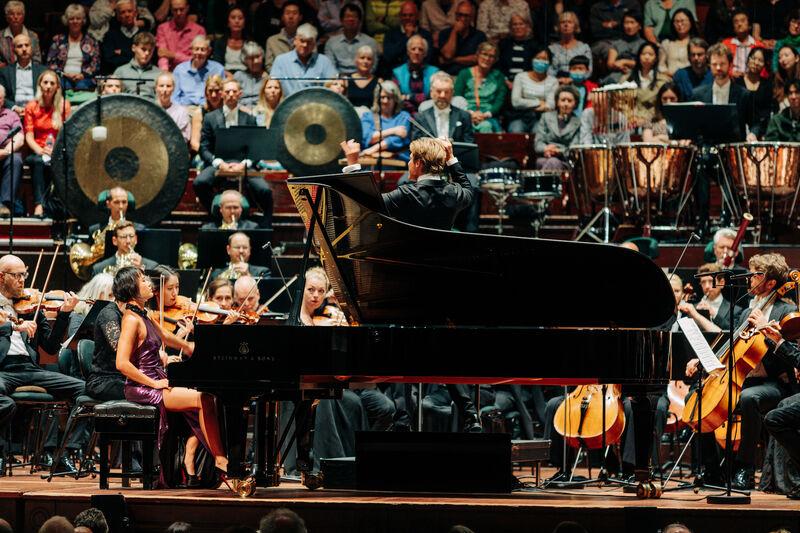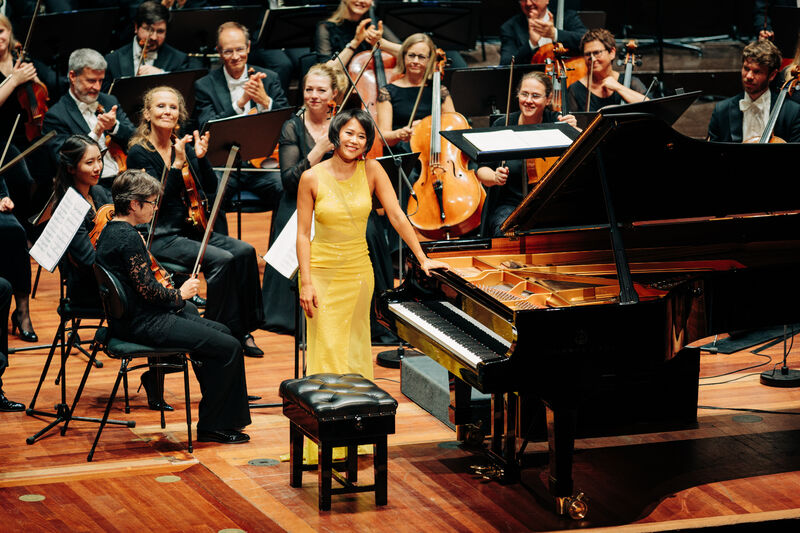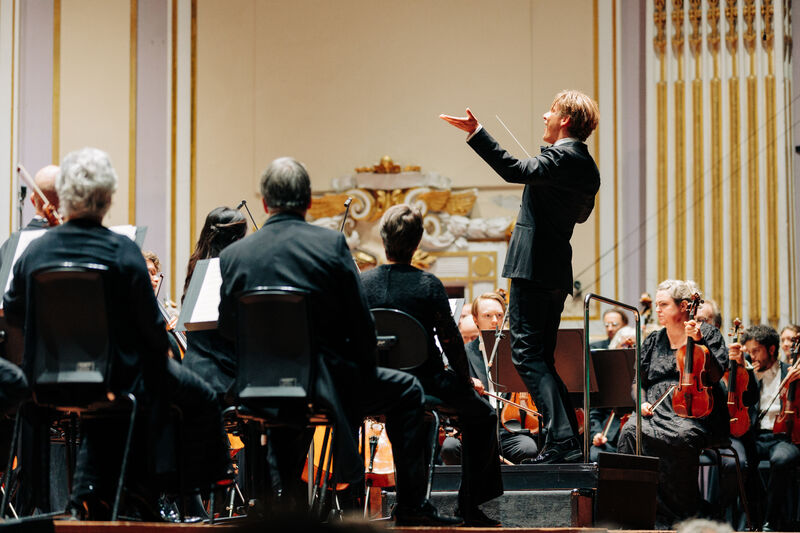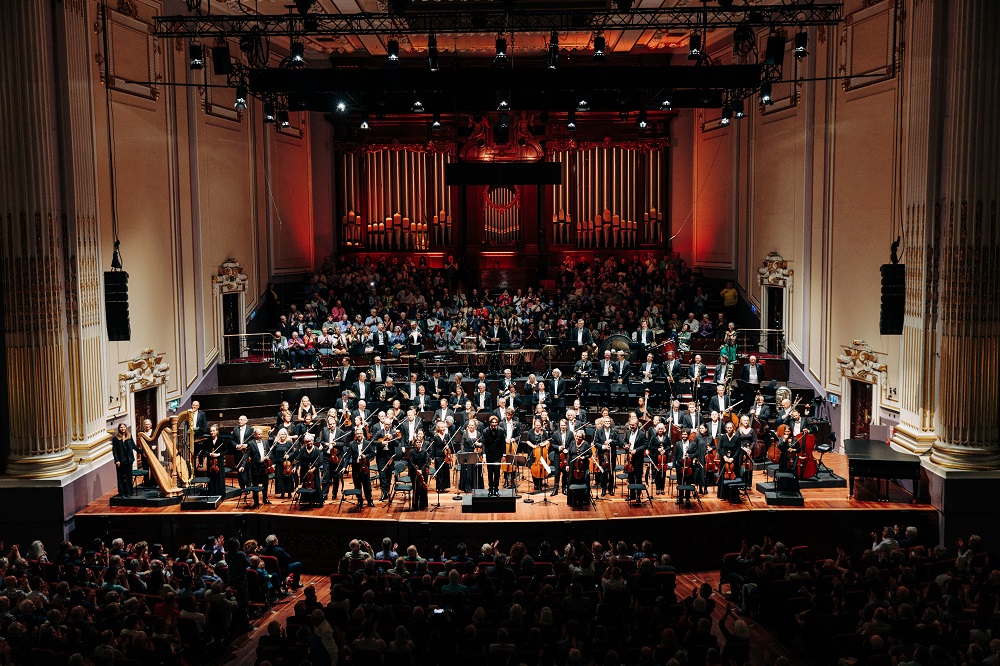Wang, Oslo Philharmonic, Mäkelä, Edinburgh International Festival 2023 review - sparkling concertos, bleak Shostakovich | reviews, news & interviews
Wang, Oslo Philharmonic, Mäkelä, Edinburgh International Festival 2023 review - sparkling concertos, bleak Shostakovich
Wang, Oslo Philharmonic, Mäkelä, Edinburgh International Festival 2023 review - sparkling concertos, bleak Shostakovich
Power sometimes over-urged, but this was quite a programme

Every time I have heard Ravel’s Piano Concerto for the Left Hand, some wiseacre in the bar afterwards trots out the predictable joke that it’s a cheap concert as the pianist gets only half the fee. For all that this is obviously nonsense, most pianists go on to play a two-handed encore to set the record straight. Yuja Wang, in her Edinburgh Festival concert with the Oslo Philharmonic Orchestra, chose to play a whole other piano concerto, in this case the same composer's G major.
The two concertos required a change of costume for our flamboyant soloist, from shimmering purple to sunset yellow (pictured below), but the similarities between the concertos are greater than the differences. Both inhabit a similar, jazz-imbued universe, and require near-chamber forces, even if the Left Hand Concerto is more heavily weighted, at times grandiose, by contrast with the gossamer lightness of the G major. The programme note helpfully points out that there are in fact more notes in the Left-Hand Concerto.  There was much zest and glitter to enjoy in both these performances, but I’m not sure how much pillow talk the Oslo Philharmonic’s young Chief Conductor Klaus Mäkelä had devoted to discussing with Wang their joint approach to tempi and dynamics for the two concertos. He seemed inclined to crack on at pace, particularly in the Left-Hand Concerto, whereas she tended to put the brakes on. It seemed a bit edgy, but maybe there are risks you can take when you know your soloist really well. Her playing is a delight, wonderfully light and fluid, particularly in the second cadenza, but when orchestra and soloist were playing together I found the former a shade too loud, even with minimal instrumentation. There’s nothing like an exception to prove the rule, however, so special mention for Min Hua Chiu’s exquisitely judged cor anglais solo in the second movement of the G major Concerto.
There was much zest and glitter to enjoy in both these performances, but I’m not sure how much pillow talk the Oslo Philharmonic’s young Chief Conductor Klaus Mäkelä had devoted to discussing with Wang their joint approach to tempi and dynamics for the two concertos. He seemed inclined to crack on at pace, particularly in the Left-Hand Concerto, whereas she tended to put the brakes on. It seemed a bit edgy, but maybe there are risks you can take when you know your soloist really well. Her playing is a delight, wonderfully light and fluid, particularly in the second cadenza, but when orchestra and soloist were playing together I found the former a shade too loud, even with minimal instrumentation. There’s nothing like an exception to prove the rule, however, so special mention for Min Hua Chiu’s exquisitely judged cor anglais solo in the second movement of the G major Concerto.
The audience responded with enthusiastic applause, as well they might, for this double bill from a superstar pianist, but despite dragging her back on stage several times she couldn’t be persuaded to an encore – “well, she has just played two concertos,” said the man next to me.  After the interval we saw a much larger orchestra pushing at the limits of the Usher Hall stage for a performance of Shostakovich’s evergreen Fifth Symphony. This is arguably the easiest of Shostakovich’s symphonies to listen to, but it is not necessarily the easiest to understand. Its famous attribution as “a Soviet artist’s response to just criticism” makes it easy to pigeonhole as a compliant work designed to curry favour with the authorities. But that very much depends on the performance, and in Mäkelä’s meticulous interpretation, I believe we saw something entirely different.
After the interval we saw a much larger orchestra pushing at the limits of the Usher Hall stage for a performance of Shostakovich’s evergreen Fifth Symphony. This is arguably the easiest of Shostakovich’s symphonies to listen to, but it is not necessarily the easiest to understand. Its famous attribution as “a Soviet artist’s response to just criticism” makes it easy to pigeonhole as a compliant work designed to curry favour with the authorities. But that very much depends on the performance, and in Mäkelä’s meticulous interpretation, I believe we saw something entirely different.
In the justly famous Largo, a slow movement that apparently moved the audience at its premiere to tears, there was no consolation. Mäkelä’s tuttis expressed either solemn resignation or the great cry of anguish of a people repressed. The haunting solos for flute, oboe, and clarinet are individual voices from the crowd, but felt as though suspended by a thread over the quietest, most tentative of string tremolandos (where was this control in the Ravel?).  The scurry and flurry of the scherzo had a nightmare quality, as though we had gone to the park to have a nice time but round every corner there’s a bandstand with musicians hacking out the same gruesome music. In the two outer movements Mäkelä once again focused on the voice of the individual in the crowd, drawing out the precarious and exposed solos the better to express their vulnerability. Both movements have degree of martial pomp, but in this interpretation the tub thumping brashness was rendered as a cynical afterthought by the poignancy of what had preceded it.
The scurry and flurry of the scherzo had a nightmare quality, as though we had gone to the park to have a nice time but round every corner there’s a bandstand with musicians hacking out the same gruesome music. In the two outer movements Mäkelä once again focused on the voice of the individual in the crowd, drawing out the precarious and exposed solos the better to express their vulnerability. Both movements have degree of martial pomp, but in this interpretation the tub thumping brashness was rendered as a cynical afterthought by the poignancy of what had preceded it.
Conducting without a score, Mäkelä conjured an impressive and revelatory performance of a symphony of pivotal importance in the history of 20th century music. It would be nice to think that even over a gap of almost a century there should be a degree of empathy between a charismatic conductor already launched on a glittering international career and a similarly young composer putting notes on a stave not only to rebuild his reputation but to save his life.
rating
Explore topics
Share this article
more Classical music
 Queyras, Philharmonia, Suzuki, RFH review - Romantic journeys
Japan's Bach maestro flourishes in fresh fields
Queyras, Philharmonia, Suzuki, RFH review - Romantic journeys
Japan's Bach maestro flourishes in fresh fields
 Classical CDs: Swans, hamlets and bossa nova
A promising young pianist's debut disc, plus Finnish mythology and a trio of neglected British composers
Classical CDs: Swans, hamlets and bossa nova
A promising young pianist's debut disc, plus Finnish mythology and a trio of neglected British composers
 Christian Pierre La Marca, Yaman Okur, St Martin-in-The-Fields review - engagingly subversive pairing falls short
A collaboration between a cellist and a breakdancer doesn't achieve lift off
Christian Pierre La Marca, Yaman Okur, St Martin-in-The-Fields review - engagingly subversive pairing falls short
A collaboration between a cellist and a breakdancer doesn't achieve lift off
 Ridout, Włoszczowska, Crawford, Lai, Posner, Wigmore Hall review - electrifying teamwork
High-voltage Mozart and Schoenberg, blended Brahms, in a fascinating programme
Ridout, Włoszczowska, Crawford, Lai, Posner, Wigmore Hall review - electrifying teamwork
High-voltage Mozart and Schoenberg, blended Brahms, in a fascinating programme
 Sabine Devieilhe, Mathieu Pordoy, Wigmore Hall review - enchantment in Mozart and Strauss
Leading French soprano shines beyond diva excess
Sabine Devieilhe, Mathieu Pordoy, Wigmore Hall review - enchantment in Mozart and Strauss
Leading French soprano shines beyond diva excess
 Špaček, BBC Philharmonic, Bihlmaier, Bridgewater Hall, Manchester review - three flavours of Vienna
Close attention, careful balancing, flowing phrasing and clear contrast
Špaček, BBC Philharmonic, Bihlmaier, Bridgewater Hall, Manchester review - three flavours of Vienna
Close attention, careful balancing, flowing phrasing and clear contrast
 Watts, BBC Symphony Orchestra and Chorus, Bignamini, Barbican review - blazing French masterpieces
Poulenc’s Gloria and Berlioz’s 'Symphonie fantastique' on fire
Watts, BBC Symphony Orchestra and Chorus, Bignamini, Barbican review - blazing French masterpieces
Poulenc’s Gloria and Berlioz’s 'Symphonie fantastique' on fire
 Bell, Perahia, ASMF Chamber Ensemble, Wigmore Hall review - joy in teamwork
A great pianist re-emerges in Schumann, but Beamish and Mendelssohn take the palm
Bell, Perahia, ASMF Chamber Ensemble, Wigmore Hall review - joy in teamwork
A great pianist re-emerges in Schumann, but Beamish and Mendelssohn take the palm
 First Persons: composers Colin Alexander and Héloïse Werner on fantasy in guided improvisation
On five new works allowing an element of freedom in the performance
First Persons: composers Colin Alexander and Héloïse Werner on fantasy in guided improvisation
On five new works allowing an element of freedom in the performance
 First Person: Leeds Lieder Festival director and pianist Joseph Middleton on a beloved organisation back from the brink
Arts Council funding restored after the blow of 2023, new paths are being forged
First Person: Leeds Lieder Festival director and pianist Joseph Middleton on a beloved organisation back from the brink
Arts Council funding restored after the blow of 2023, new paths are being forged
 Classical CDs: Nymphs, magots and buckgoats
Epic symphonies, popular music from 17th century London and an engrossing tribute to a great Spanish pianist
Classical CDs: Nymphs, magots and buckgoats
Epic symphonies, popular music from 17th century London and an engrossing tribute to a great Spanish pianist
 Sheku Kanneh-Mason, Philharmonia Chorus, RPO, Petrenko, RFH review - poetic cello, blazing chorus
Atmospheric Elgar and Weinberg, but Rachmaninov's 'The Bells' takes the palm
Sheku Kanneh-Mason, Philharmonia Chorus, RPO, Petrenko, RFH review - poetic cello, blazing chorus
Atmospheric Elgar and Weinberg, but Rachmaninov's 'The Bells' takes the palm

Add comment